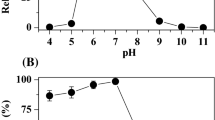Abstract
Selection for utilization of carboxy-Orange I [1-(4′-carboxyphenylazo)-4-naphthol] in the chemostat yielded Pseudomonas strain K24 which was unable to grow on carboxy-Orange II [1-(4′-carboxyphenylazo)-2naphthol] while selection for growth on carboxy-Orange II had previously led to strain KF 46 which did not utilize carboxy-Orange I. Orange I azoreductase of strain K24, the key enzyme of dye degradation, was purified 80-fold with 17% yield to electrophoretic homogeneity and compared to the previously purified Orange II azoreductase of strain KF46. Common properties of the two enzymes were their monomeric structure, their specificity for NADPH and NADH as cosubstrates, the range of their K m values for substrates and cosubstrates as well as their reactivity towards a series of substrate analogs. They differed from each other with respect to molecular weight (21,000 and 30,000) and in the absolute requirement of Orange I azoreductase for a hydroxy group in the 4′ position of the naphthol ring of the substrate molecule as compared to the requirement for substrates with a 2-naphthol moiety by Orange II azoreductase. The pure enzymes did not exhibit immunological cross-reaction with each other. Crude extracts of strains K24 and KF46 and of azoreductase-negative strains isolated at different stages of the adaptation experiments, however, contained material which cross-reacted (CRM) with both anti Orange I azoreductase serum and anti Orange II azoreductase serum. The CRM may represent a common precursor protein of the azoreductases in strains K24 and KF46.
Similar content being viewed by others
Abbreviations
- Orange I:
-
1-(4′-sulfophenylazo)-4-naphthol
- carboxy-Orange I:
-
1-(4′-carboxy phenylazo)-4-naphthol
- Orange II:
-
1-(4′-sulfophenylazo)-2-naphthol
- carboxy-Orange II:
-
1-(4′-carboxyphenylazo)-2-naphthol
- SDS:
-
sodium dodecyl sulfate
- DCAB:
-
4,4′-dicarboxyazobenzene
- CRM:
-
cross reacting material
- anti OrIar serum:
-
antiserum against Orange I azoreductase
- anti OrIIar serum:
-
antiserum against Orange II azoreductase
- Orange I azoreductase or NAD(P)H:
-
1-(4′-sulfophenylazo)-4-naphthol oxidoreductase (EC 1.6.6-)
- Orange II azoreductase or NAD(P)H:
-
1-(4′-sulfophenylazo)-2-naphthol oxidoreductase (EC 1.6.6-)
References
Arnheim N (1973) The evolution of proteins. In: Sela M (ed) The antigens, vol 1. Academic Press, New York London, pp 377–416
Arnon R (1971) Antibodies to enzymes. A tool in the study of antigenic specificity determinants. Curr Topics Microbiol Immun 54:47–93
Bowien B, Mayer F (1978) Further studies on the quaternary structure of d-ribulose-1,5-bisphosphate carboxylase from Alcaligenes eutrophus. Eur J Biochem 88:97–107
Giffhorn F, Zimmermann Th, Kuhn A (1981) Substrate specificity of citrate lyase deacetylase of Rhodopseudomonas gelatinosa and Rhodopseudomonas pallustris. J Bacteriol 147:463–470
Halwachs W (1978) K m and V max from only one experiment. Biotechnol Bioeng 20:281–285
Kabat EA, Mayer MM (1964) Experimental immunochemistry. Thomas, Springfield, USA
Kulla HG (1981) Aerobic bacterial degradation of azo dyes. In: Leisinger Th, Cook AM, Hütter R, Nüesch J (eds) Microbial degradation of xenobiotics and recalcitrant compounds. Academic Press, London New York, pp 387–399
Kulla HG, Klausener F, Meyer U, Lüdeke B, Leisinger Th (1983) Interference of aromatic sulfo groups in the microbial degradation of the azo dyes Orange I and Orange II. Arch Microbiol 135:1–7
Lowry OH, Rosebrough NJ, Farr AL, Randall RJ (1951) Protein measurement with the Folin phenol reagent. J Biol Chem 193:265–275
Schlegel HG (1981) Allgemeine Mikrobiologie. Thieme, Stuttgart
Weber K, Osborn M (1969) The reliability of molecular weight determinations by dodecyl sulfate-polyacrylamide gel electrophoresis. J Biol Chem 244:4406–4412
Zimmermann Th, Kulla HG, Leisinger Th (1982) Properties of purified Orange II azoreductase, the enzyme initiating azo dye degradation by Pseudomonas KF 46. Eur J Biochem 129:197–203
Zollinger H (1961) Azo and diazo chemistry: aliphatic and aromatic compounds. Interscience Publishers, New York London
Author information
Authors and Affiliations
Rights and permissions
About this article
Cite this article
Zimmermann, T., Gasser, F., Kulla, H.G. et al. Comparison of two bacterial azoreductases acquired during adaptation to growth on azo dyes. Arch. Microbiol. 138, 37–43 (1984). https://doi.org/10.1007/BF00425404
Received:
Accepted:
Issue Date:
DOI: https://doi.org/10.1007/BF00425404




